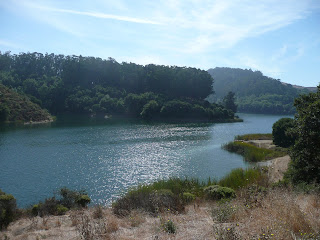 |
| Nice views in Big Sur. |
 |
| Post-race fat loading at Nepenthe along Route 1. |
The park is in the famous Big Sur area and gave Amy and myself a chance to see the a long section of coastline used in the Big Sur marathon (which I'm now really excited about doing next year), including the 1932 Bixby Bridge.
Even though the race was in the park, it followed the river and was on the roads instead of trails so was a fast course. It's also fairly old and established, with this being the 30th running.
Anyway, I've felt more normal in training for the past week so tried a 5k on the treadmill on Thursday and almost collapsed during it, but managed 16:29 for a PB. Wasn't sure whether that would leave me too tired for Saturday morning (it was a really tough session and I've avoided hard sessions for a while), but today went well with a new 10k PB of 34:38 and third. Had to run myself into the ground to not slow down and spent the whole time trying to hold on to the coat tails of the guy in third until I just squeezed past near the end.
So it was satisfying to have two mentally and physically tough runs close together. From what I've been learning from Tim Noakes' 'Lore of Running' (am still getting through this bible-sized tome), teaching the brain's 'central governor' how to push harder and allow me to run faster is the key to improving. That should mean that every hard run I do where I don't give in and allow myself to slow, even as my heart rate soars, would make it easier for next time. This isn't just improving mental toughness, but teaching the mind's natural mechanism for protecting the heart muscle from oxygen depletion how to accept higher effort levels (it's too conservative and has been shown by Noakes to be more of a limiting factor than oxygen and energy stores to the legs and arms).
His book is fascinating and completely science-based, explaining the flaw in the generally accepted paradigm that an athlete's performance is determined mainly by VO2 max. He shows how performance drops off even though there is still energy and oxygen enough for the outer muscles. Instead, it's the oxygen available to the heart that sends triggers to the brain to force the 'central governor' to kick in and force the body to feel more fatigue than the arms and legs justify. I've butchered the explanation and shortened many chapters into two paragraphs, but I can appreciate the logic and science he uses to back it up. Plus I'm sure I'm not the only one who knows how much easier it is to do a particular time or performance for the second time. This was very clear to me in my second sub 3-hour marathon, which was much easier than the first because my brain was willing to accept I could take it, so it didn't try to hold me back to protect the heart. It had been taught that that level of effort was ok, even though I hadn't got any fitter in the intervening month.
 |
| Bixby Bridge, Big Sur |























